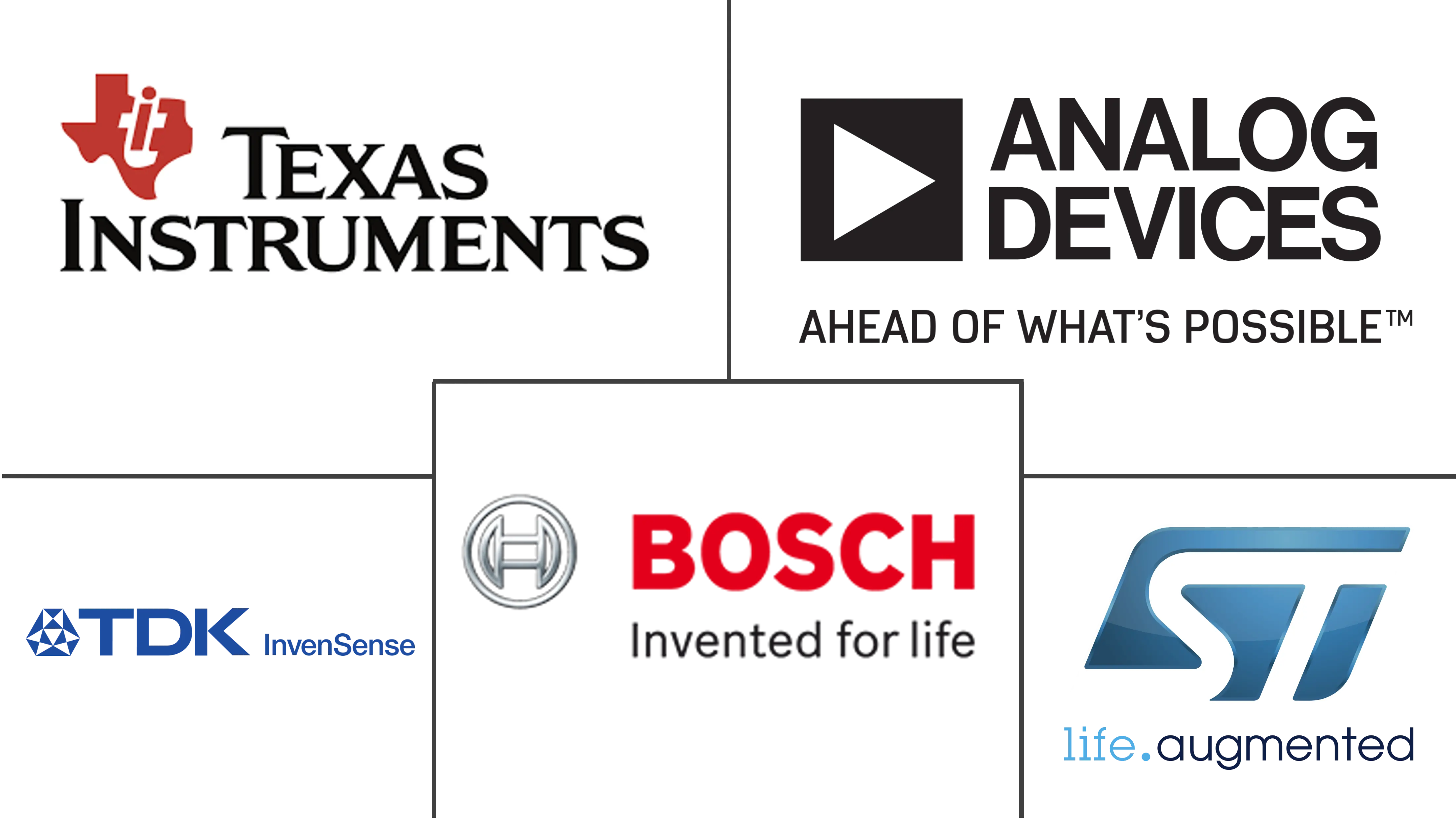Wearable Motion Sensors Market Size and Share
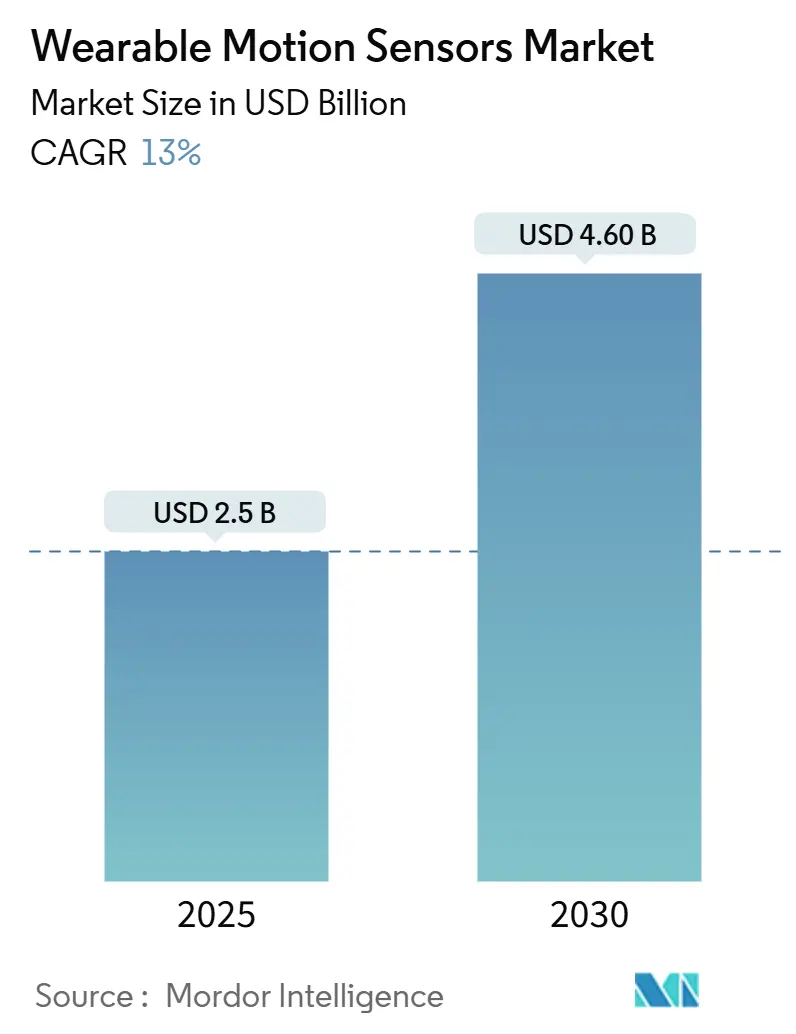
Wearable Motion Sensors Market Analysis by Mordor Intelligence
The wearable motion sensors market size is valued at USD 2.5 billion in 2025 and is forecast to reach USD 4.6 billion by 2030, registering a 12.97% CAGR over the period. Expanding adoption across healthcare, consumer electronics, industrial safety and defense sustains this trajectory, while breakthroughs in miniaturization and on-device signal processing convert once-discrete components into indispensable enablers of connected products. Demand is reinforced by regulatory support for remote patient monitoring, rising health-conscious consumer behavior, and the shift toward seamless human–machine interfaces that rely on precise real-time motion data. Market leaders emphasize sensor fusion, ultra-low-power design and edge AI to differentiate, whereas emerging players target niche opportunities such as smart textiles and soldier modernisation. Supply-side constraints in MEMS manufacturing and growing compliance costs tied to data sovereignty remain the most visible bottlenecks for timely capacity fulfilment.
Key Report Takeaways
- By type, accelerometers led with 32.4% of the wearable motion sensors market share in 2024, while MEMS combo sensors post the highest 14.66% CAGR through 2030.
- By application, fitness bands accounted for 24% share of the wearable motion sensors market size in 2024; smart clothing advances at a 14.91% CAGR to 2030.
- By end-user industry, consumer electronics & lifestyle held 31% of the wearable motion sensors market in 2024, and is expected to expand at a 15% CAGR to 2030.
- By geography, North America commanded 42.7% revenue share in 2024, whereas Asia Pacific is projected to grow fastest at 16.91% between 2025 and 2030.
Global Wearable Motion Sensors Market Trends and Insights
Drivers Impact Analysis
| DRIVER | (~) % IMPACT ON CAGR FORECAST | GEOGRAPHIC RELEVANCE | IMPACT TIMELINE |
|---|---|---|---|
| AI-enabled sensor fusion driving medical-grade wearables | +2.8% | Global, early in North America | Medium term (2-4 years) |
| Sub-milliwatt MEMS for eldercare in Japan & Korea | +1.5% | Japan, South Korea, spillover China | Medium term (2-4 years) |
| U.S. RPM reimbursement boost | +2.1% | United States | Short term (≤ 2 years) |
| EU Digital Product Passport-linked usage analytics | +1.2% | European Union | Medium term (2-4 years) |
| Micro energy-harvesting modules in China | +1.7% | China, spillover Asia Pacific | Medium term (2-4 years) |
| NATO soldier modernisation demand | +1.1% | North America, Europe | Long term (≥ 4 years) |
| Source: Mordor Intelligence | |||
AI-enabled Sensor Fusion Driving Medical-Grade Wearables
Integrating on-sensor AI with multi-axis inertial data is converting consumer devices into clinical-grade monitors, enabling reliable detection of subtle gait or tremor changes linked to Parkinson’s and other neuro-motor disorders. Studies report 84% accuracy in differentiating early Parkinson’s tremor from essential tremor, an achievement that expands home-based, continuous care models and reduces reliance on episodic clinical evaluations. Growing payer acceptance of algorithm-supported diagnostics accelerates hospital adoption, while consumer brands add medical features to retain users within ecosystem subscriptions.[1]D. Perera et al., “AI-Enhanced IMU Classification of Parkinsonian Tremor,” frontiersin.org
Sub-milliwatt MEMS for Eldercare in Japan & Korea
Sensors consuming below 1 mW allow multi-week operation without charging, a prerequisite for elderly users who may forget to maintain devices. Japan’s national long-term care system saw 23% fewer hospitalisations when such sensors enabled automatic fall alerts and daily activity profiling. Korean public-private pilots demonstrate similar savings, encouraging scale-up across community health networks and driving regional demand spillover into China’s ageing-at-home initiatives.
U.S. RPM Reimbursement Boost
New CPT codes effective January 2026 pay clinicians for remote patient monitoring hardware and daily reviews, transforming economic incentives for continuous motion tracking in post-acute rehabilitation and fall prevention. The American Medical Association’s code-set expansion, coupled with CMS goals for value-based care penetration, lowers procurement risk for hospitals that deploy sensor-equipped wearables. Vendor pipelines now prioritise FDA-cleared motion algorithms to meet audit requirements.
EU Digital Product Passport-Linked Usage Analytics
From July 2024, every smart wearable entering the EU must carry a digital identifier linking to origin, material composition and repair information. Progressive manufacturers upload anonymised usage statistics to the same portal, leveraging compliance infrastructure to refine product design, battery management and predictive maintenance strategies. Premium buyers reward brands that prove longevity and sustainability, nudging the market toward data-rich lifecycle services.
Restraints Impact Analysis
| RESTRAINTS | (~) % IMPACT ON CAGR FORECAST | GEOGRAPHIC RELEVANCE | IMPACT TIMELINE |
|---|---|---|---|
| Algorithmic limits on tremor differentiation | -1.2% | Global, higher in North America & Europe | Medium term (2-4 years) |
| MEMS foundry capacity crunch | -1.8% | Global, peak Asia Pacific | Short term (≤ 2 years) |
| Data-sovereignty compliance costs | -1.4% | EU, North America | Medium term (2-4 years) |
| Smart-textile interconnect failures | -1.0% | Global | Short term (≤ 2 years) |
| Source: Mordor Intelligence | |||
Algorithmic Limits on Tremor Differentiation
Current unsupervised models reach only 57.1% accuracy in multi-class tremor severity classification, well below clinical thresholds, limiting reimbursement for neurological wearables. Small, diverse data sets and noisy real-world environments hinder progress, slowing hospital uptake despite promising research prototypes.[2]R. Patel, “Accuracy Limits in Tremor Classification,” mdpi.com
MEMS Foundry Capacity Crunch
Automotive ADAS, 5G handsets and IoT modules collectively outpace the 15% yearly wafer expansion at leading MEMS fabs, leaving a 7% shortfall for wearables. Brands without captive facilities face bid-up prices or allocation cuts as vertically integrated suppliers like Bosch prioritise in-house demand.
Segment Analysis
By Type: MEMS Combo Sensors Redefine Power–Performance Paradigm
The wearable motion sensors market saw accelerometers retain 32.4% share in 2024, underpinning activity trackers, gesture interfaces and basic fall detection. That dominance reflects mature cost curves and micro-amp sleep currents. In contrast, MEMS combo sensors post a 14.66% CAGR by fusing accelerometer, gyroscope and magnetometer functions within a single ASIC that off-loads board-level integration. STMicroelectronics’ LSM6DSV16BX, for instance, embeds a 6-axis IMU plus an audio accelerometer for bone-conduction-based commands in hearables. Combo adoption narrows the performance gap with discrete IMUs while lowering power draw, ideal for tiny rings and medical patches.[3]M. Nehra, “All-in-One MEMS for Hearables,” audioxpress.com
Gyroscopes support sub-degree orientation fidelity in AR/VR headsets and advanced biomechanics analysis yet carry higher milliwatt budgets, so vendors pair duty-cycled modes with predictive algorithms to stretch per-charge runtime. Magnetometers deliver absolute heading, essential for outdoor sports watches navigating GPS multipath. Pressure sensors, a smaller but vital niche, calibrate altitude change for stair-climb counting and swimming lap depth. Forward-looking roadmaps integrate bio-potential or chemical channels alongside motion axes, signalling a future where inertial and physiological data converge inside unified sensor nodes, further strengthening the wearable motion sensors market.
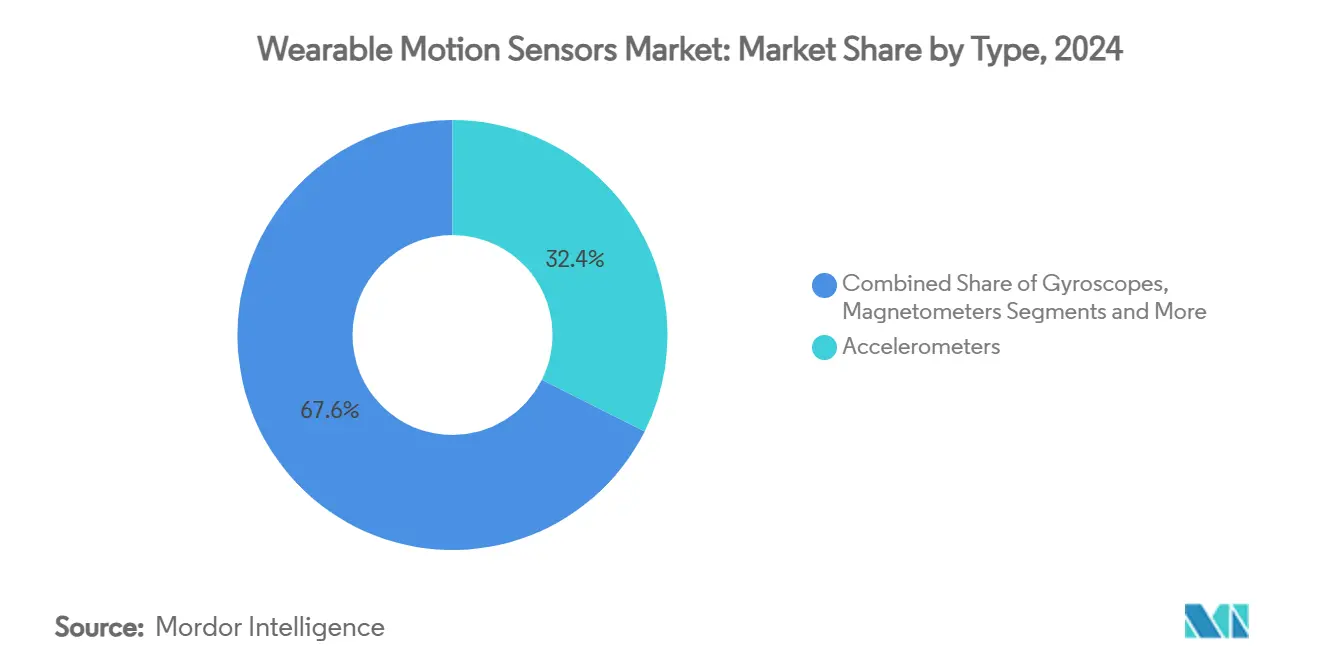
Note: Segment shares of all individual segments available upon report purchase
By Application: Smart Clothing Weaves Sensing into Everyday Wear
Fitness bands led 24% of application revenues in 2024, benefiting from established brand ecosystems, low entry price and cross-selling of subscription analytics. However, textile-embedded sensor threads shift monitoring from gadget to garment, supporting a 14.91% CAGR through 2030. Conductive yarns and printed stretch sensors enable shirts that track joint kinematics, posture and respiratory rates during daily routines, freeing users from dedicated devices.
AR/VR headsets remain a high-growth enclave, demanding sub-millisecond latency orientation updates for immersive simulation. Ear-wear integrates head-gesture sensing for hands-free calls, while smart rings deliver sleep staging in tiny form factors. The convergence of motion and electrochemical sensing within fabrics widens health dashboards to hydration, electrolyte loss and thermal stress parameters, underscoring how seamless experiences keep the wearable motion sensors market expanding beyond novelty phases.
By End-user Industry: Consumer Electronics Drives Volume, Healthcare Demands Precision
Consumer electronics & lifestyle captured 31% revenue in 2024 and will compound at 15% through 2030 as mainstream brands integrate fall detection and basic ECG into watches, lowering barriers to preventative health engagement. Gamified dashboards, wellness challenges and insurer incentives extend replacement cycles, solidifying the wearable motion sensors market foundation.
Healthcare & medical devices deliver higher margins but demand rigorous ISO13485 controls and FDA validation. Rehabilitation clinics deploy inertial modules on knees and hips to score gait recovery, while cardiology groups pilot arrhythmia prediction from combined motion and optical signals. Industrial safety kits rely on rugged IMUs for slip detection and man-down alerts, whereas soldier systems layer over-the-air encryption and high-g tolerance ratings. Technology cross-pollination among these domains accelerates features migration, reinforcing the competitive yet symbiotic ecosystem that underpins the wearable motion sensors industry.
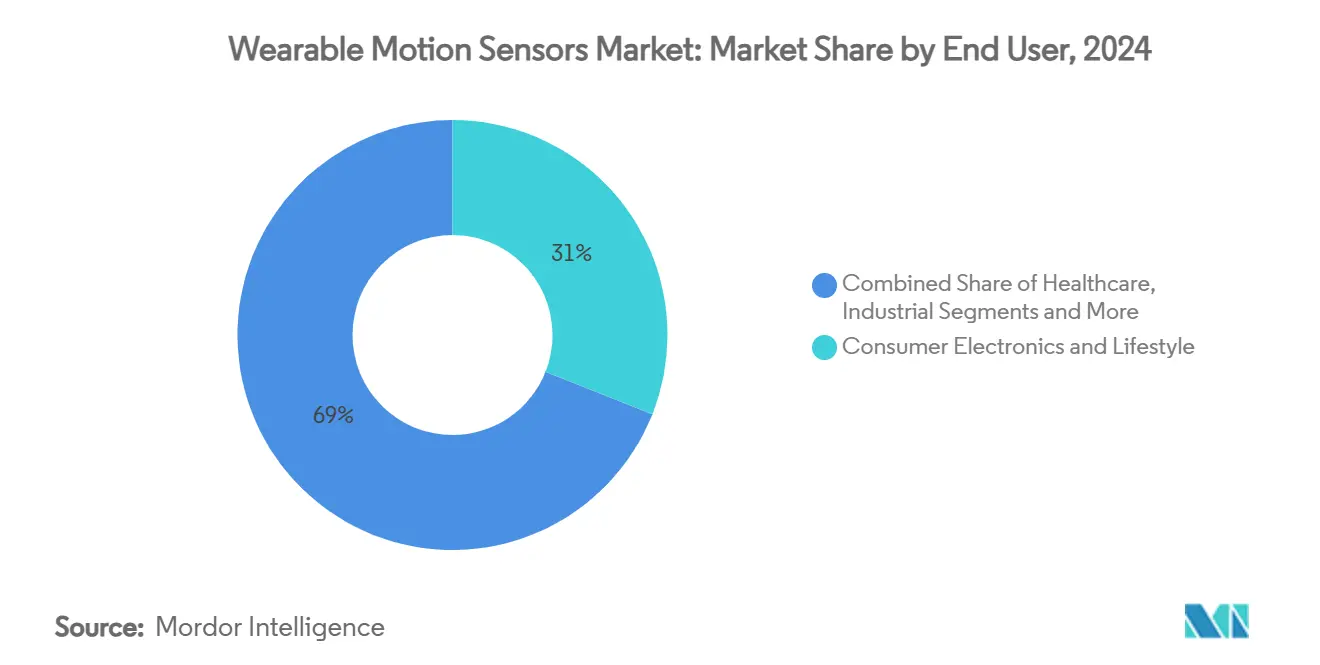
Note: Segment shares of all individual segments available upon report purchase
By Power Consumption: Ultra-Low Power Catalyses Continuous Monitoring
Ultra-low-power devices below 1 mW form the fastest-growing slice, enabling multi-week unattended deployment on disposable batteries or energy harvesters. Japan’s eldercare pilots prove that sensors drawing 0.9 mW extend patch wear time to 21 days, raising data continuity and clinical insight. Low-power units (1–10 mW) occupy mass-market wearables such as sports watches where daily charging is acceptable, balancing sample rate and battery size.
Standard-power sensors (10–50 mW) dominate AR/VR controllers and enterprise safety helmets that off-load energy to swappable battery packs. High-power modules above 50 mW, typically integrating radar or active haptic feedback, cater to specialized training rigs and defense wearables but face scrutiny for thermal output. A progressive shift down the power ladder is evident as fabs migrate to 0.8-µm piezo-MEMS and on-chip deep-sleep orchestrators. Energy autonomy remains a differentiator, strengthening brand claims of sustainability and reinforcing growth prospects for the wearable motion sensors market size attached to sub-milliwatt categories.
Geography Analysis
North America generated 42.7% of 2024 revenue, anchored by Medicare reimbursement reform that locks remote motion monitoring into mainstream care pathways. The region’s venture ecosystem funnels capital into edge-AI silicon, while privacy statutes push vendors toward on-device inference, preserving user trust. Supply constraints are mitigated by near-shoring policies and Defense Production Act incentives that favour domestic MEMS lines.
Asia Pacific registers the fastest 16.91% CAGR through 2030, reflecting China’s tier-2 fabs embracing energy-harvesting architectures and Korea’s smart-city pilots embedding motion tags in elder apartments. Government grants offset initial higher BOM costs, while consumer appetite for feature-rich wearables remains unabated. Japan’s insurers reimburse smart-shirt-based risk scoring for seniors, spurring textile sensor investment.
Europe maintains methodical expansion, its Digital Product Passport mandate pushing life-cycle transparency and fostering premium after-sales analytics. GDPR compliance elevates spend on secure edge firmware and sovereign cloud bridges. Latin America and the Middle East & Africa trail in volumes yet notch double-digit growth where urban private hospitals adopt fall-detection watches. Cross-border e-commerce and multinational OEM assembly lines stitch regions into a globally interdependent wearable motion sensors market.
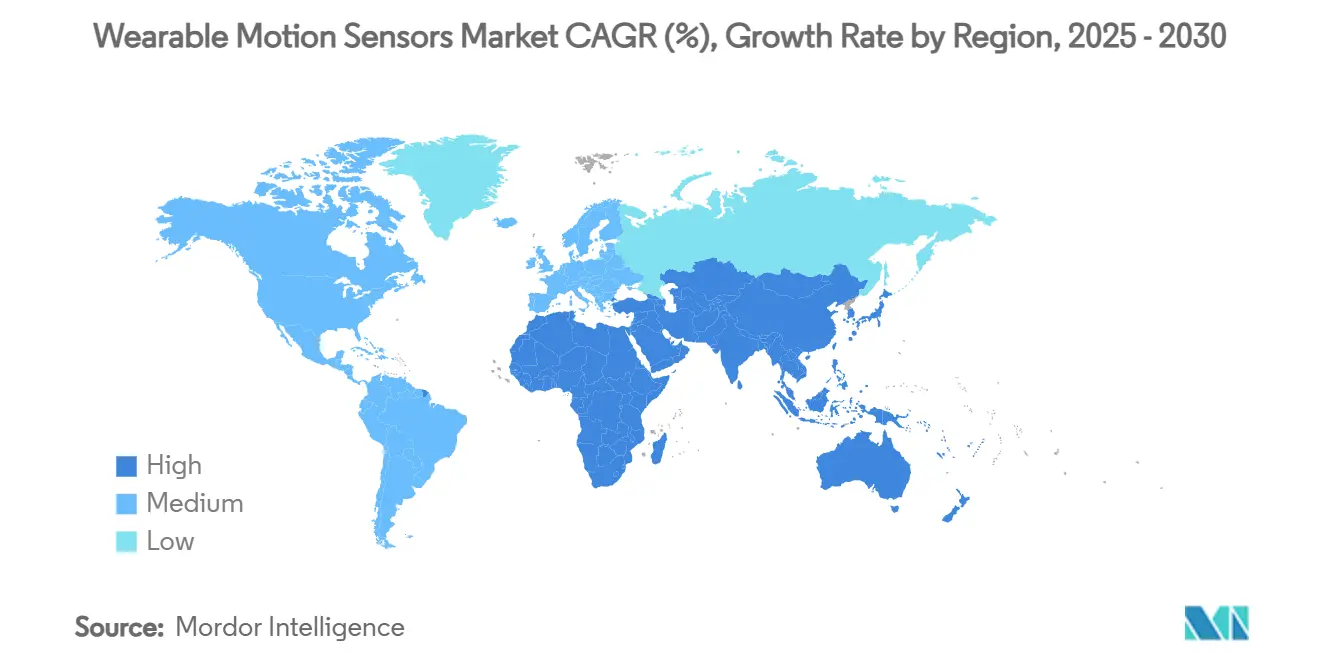
Competitive Landscape
The top five suppliers account for roughly 55–60% of unit shipments, rendering the field moderately concentrated. STMicroelectronics, Bosch Sensortec, TDK InvenSense, Analog Devices and NXP scale through captive fabs and broad portfolios, but face agile specialists exploiting underserved niches. Tech differentiation centres on embedded MCU cores, sensor fusion IP and wafer-level 3-D packaging that slashes z-height for jewelry formats.
Patent races intensify: STMicroelectronics alone lists over 18,000 active filings with MEMS claims in machine-learning-the-edge use cases. Concurrently, consumer OEMs like Apple and Samsung invest in proprietary inertial modules, heightening vertical integration and bargaining power over merchant vendors. Fab-capacity scarcity further motivates long-term silicon supply agreements, creating barriers for late entrants yet opening alliances with alternative piezoelectric MEMS developers that promise simpler tooling.
Disruptors harness printable nanomaterials for textile sensors and leverage cloudless AI to skirt privacy hurdles. Meanwhile, established incumbents acquire boutique design houses—Analog Devices’ USD 280 million purchase of Tronic Microsystems expands piezo-MEMS and vacuum packaging know-how—to pre-empt gaps in next-gen roadmaps. The result is dynamic competition that continually redefines value pools within the wearable motion sensors market.
Wearable Motion Sensors Industry Leaders
-
Analog Devices Inc.
-
Bosch Sensortec GmbH
-
TDK InvenSense
-
STMicroelectronics N.V.
-
Texas Instruments Incorporated
- *Disclaimer: Major Players sorted in no particular order
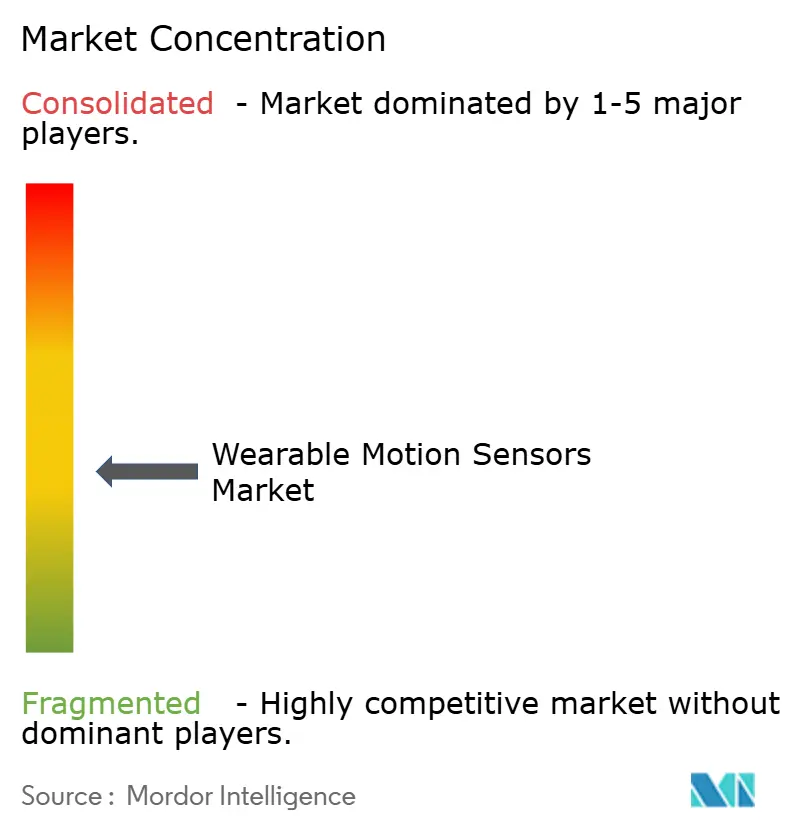
Recent Industry Developments
- April 2025: STMicroelectronics launched the LSM7DS1, a 7-axis MEMS sensor combining a 3-axis accelerometer, 3-axis gyroscope, and pressure sensor in a single package measuring just 2.5 x 3.0 x 0.8 mm, enabling more compact wearable designs while reducing power consumption by up to 30% compared to discrete sensor implementations.
- March 2025: Bosch Sensortec introduced the BMA580, the world's smallest MEMS accelerometer measuring just 1.2 x 0.8 x 0.55mm³, specifically designed for wearables and hearables with integrated voice activity detection capabilities. This ultra-compact sensor enables new form factors for wearable devices while reducing power consumption, addressing key design constraints for next-generation products.
- February 2025: TDK InvenSense announced the TWS-M602, a specialized IMU combining a 6-axis motion sensor with an accelerometer and on-chip machine learning capabilities designed specifically for true wireless earbuds.
- January 2025: Analog Devices acquired Tronic Microsystems, a specialized MEMS sensor developer, for USD 280 million to strengthen its position in ultra-low-power sensor technologies for wearable and IoT applications. This strategic acquisition expands ADI's sensor portfolio and manufacturing capabilities, particularly for healthcare and consumer wearable applications requiring extended battery life.
Global Wearable Motion Sensors Market Report Scope
A motion sensor detects the movement of a human being or an object concerning the external environment. A wearable motion sensor may track a person's movement and record the information, which can then be analyzed. It records a person's movements using gyroscopes and accelerometers.
The Wearable Motion Sensors Market is segmented by Type (Accelerometers, Inertial Gyroscopes, MEMS), by Application (Smart Watches, Fitness Bands, Activity Monitors, Smart Clothing, Sports Gear), by End-user Industry (Healthcare, Sports/Fitness, Consumer Electronics, Entertainment and Media, Government and Public Utilities), and by Geography (North America (United States, Canada), Europe (Germany, United Kingdom, Italy, France, and Rest of Europe), Asia-Pacific (China, Japan, India, and Rest of Asia-Pacific), Latin America (Brazil, Argentina, and Rest of Latin America), and Middle East and Africa (United Arab Emirates, Saudi Arabia, and Rest of Middle East & Africa)). The market sizes and forecasts are provided in terms of value (USD million) for all the above segments.
| Accelerometers |
| Gyroscopes |
| Magnetometers |
| Inertial Measurement Units (IMUs) |
| MEMS Combo Sensors |
| Pressure Sensors |
| Fitness Bands |
| Activity Monitors |
| Smart Clothing |
| AR/VR Headsets |
| Smart Rings and Jewelry |
| Ear-wear and Hearing Aids |
| Healthcare and Medical Devices |
| Consumer Electronics and Lifestyle |
| Industrial and Enterprise Safety |
| Military and Defense |
| Government and Public Utilities |
| Ultra-Low Power (Less than1mW) |
| Low Power (1-10mW) |
| Standard Power (10-50mW) |
| High Power (Greater than 50mW) |
| North America | United States |
| Canada | |
| Mexico | |
| Europe | United Kingdom |
| Germany | |
| France | |
| Italy | |
| Rest of Europe | |
| Asia-Pacific | China |
| Japan | |
| India | |
| South Korea | |
| Rest of Asia-Pacific | |
| Middle East | Israel |
| Saudi Arabia | |
| United Arab Emirates | |
| Turkey | |
| Rest of Middle East | |
| Africa | South Africa |
| Egypt | |
| Rest of Africa | |
| South America | Brazil |
| Argentina | |
| Rest of South America |
| By Type | Accelerometers | |
| Gyroscopes | ||
| Magnetometers | ||
| Inertial Measurement Units (IMUs) | ||
| MEMS Combo Sensors | ||
| Pressure Sensors | ||
| By Application | Fitness Bands | |
| Activity Monitors | ||
| Smart Clothing | ||
| AR/VR Headsets | ||
| Smart Rings and Jewelry | ||
| Ear-wear and Hearing Aids | ||
| By End-user Industry | Healthcare and Medical Devices | |
| Consumer Electronics and Lifestyle | ||
| Industrial and Enterprise Safety | ||
| Military and Defense | ||
| Government and Public Utilities | ||
| By Power Consumption | Ultra-Low Power (Less than1mW) | |
| Low Power (1-10mW) | ||
| Standard Power (10-50mW) | ||
| High Power (Greater than 50mW) | ||
| By Geography | North America | United States |
| Canada | ||
| Mexico | ||
| Europe | United Kingdom | |
| Germany | ||
| France | ||
| Italy | ||
| Rest of Europe | ||
| Asia-Pacific | China | |
| Japan | ||
| India | ||
| South Korea | ||
| Rest of Asia-Pacific | ||
| Middle East | Israel | |
| Saudi Arabia | ||
| United Arab Emirates | ||
| Turkey | ||
| Rest of Middle East | ||
| Africa | South Africa | |
| Egypt | ||
| Rest of Africa | ||
| South America | Brazil | |
| Argentina | ||
| Rest of South America | ||
Key Questions Answered in the Report
What is the current value of the wearable motion sensors market?
The market is worth USD 2.5 billion in 2025 and is on track to reach USD 4.6 billion by 2030 at a 12.97% CAGR.
Which region grows fastest through 2030?
Asia Pacific leads growth with a 16.91% CAGR, propelled by rising electronics manufacturing and healthcare spending.
How large is the accelerometers segment?
Accelerometers account for 32.4% of wearable motion sensors market share in 2024, maintaining leadership due to versatility.
What powers ultra-low-power wearables?
Devices consuming under 1 mW often pair sub-milliwatt MEMS with energy harvesters, enabling weeks of operation without charging.
Why is AI sensor fusion important?
Embedded AI improves motion pattern recognition and clinical accuracy, driving adoption in medical-grade wearables and contributing a +2.8% uplift to market CAGR.
What challenges limit smart clothing adoption?
Reliability issues in textile interconnects reduce product lifetimes, shaving an estimated 1.0% from overall market CAGR until materials advances resolve failures.
Page last updated on:
